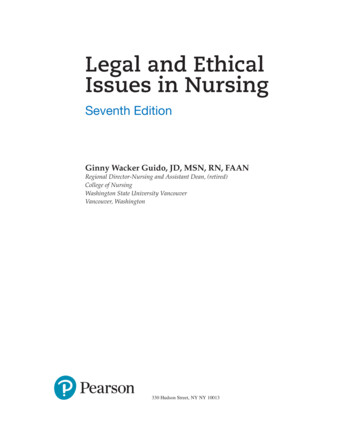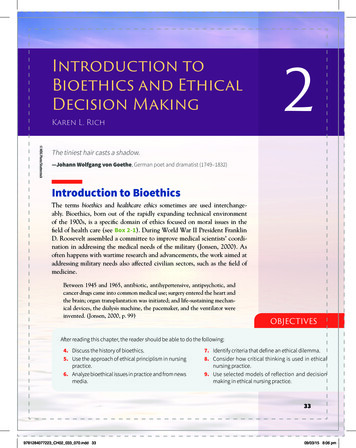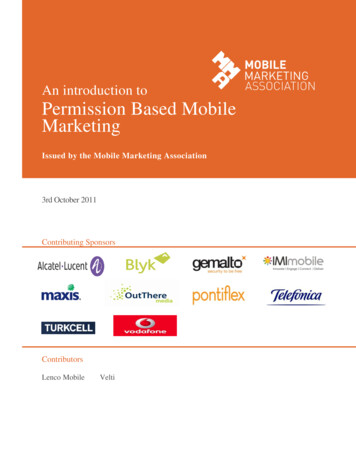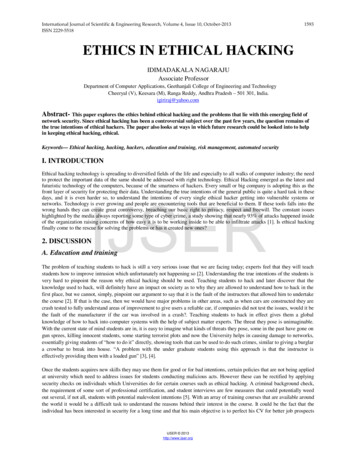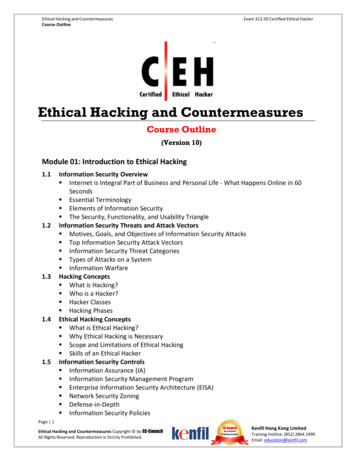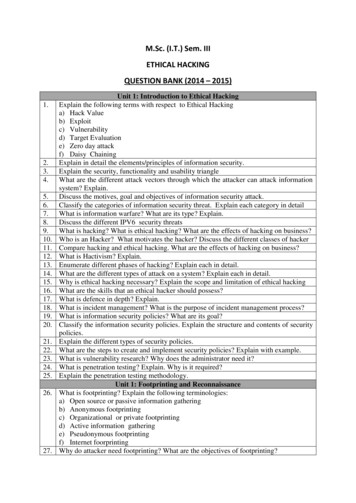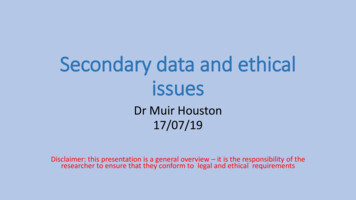
Transcription
Ethical Issues inE-PermissionMarketingA study of how consumer behaviour is affected byunethical practices involving E-Permission MarketingBACHELOR THESISTHESIS WITHIN: Business AdministrationNUMBER OF CREDITS: 15 ECTSPROGRAMME OF STUDY: MarketingManagementAUTHOR: Sameer Karimi, Yasen GerasimovStoev, Olle ZanderTUTOR: Johan LarssonJÖNKÖPING May 20171
AcknowledgementsWe would like to express our deepest gratitude to our tutor Johan Larsson for the encouragement,advice and inspiring guidance throughout the process of completing this paper. Our gratitude alsoextends to our seminar group for their great advice and continuous contribution. We would alsolike to thank friends and students who participated in our survey, as well as all other participants.Finally, we would like to thank our parents for their love and support that helped us through allthis time.Sameer KarimiYasen Gerasimov StoevOlle Zander2
Bachelor Thesis in Business AdministrationTitle: Ethical Issues in E-Permission MarketingAuthors: Sameer Karimi, Yasen Gerasimov Stoev, Olle ZanderTutor: Johan LarssonDate: 2017-05-22Key terms: e-permission marketing, marketing ethics, consumer awareness, consumer behaviour,consumer valueAbstractThe massive growth of online marketing has been extensively beneficial for marketers for thepast years. With the continuous rapid development of this sector consumers are becomingincreasingly exposed to promotional activities. One of the marketing methods that marketers useis in the recent years is online permission marketing which means that consumers agree to beinvolved in marketing activities. However, this practice could result in particular ethical issuesthat directly affect consumers without them being actually aware. Therefore, the purpose of thispaper is to investigate the degree of consumer awareness of consent in e-permission marketingand explore how consumer attitude and behaviour is affected once consumers are knowledgeableabout the existence and core nature of ethical issues in this field of marketing. This wasinvestigated by performing an exploratory study with an abductive approach and onlinequantitative survey as a tool. Data was analysed through the analytics tool SPSS. Findings fromthe analysis showed that there is a lack of consumer awareness when giving consent, and there isfocus only on perceived value. However, once aware of ethical implications and consequences,especially involving data collection practices which invade privacy, consumer behaviour andattitude changes.3
Table of ContentsChapter 1: Introduction . 71.1 Background . 71.2 Problem Discussion . 71.3 Purpose. 91.4 Research Questions. 91.5 Definitions . 9Chapter 2: Theoretical Framework. 112.1 Marketing. 112.1.1 Digital Marketing . 122.1.2 Permission Marketing . 132.2 Consumer Behaviour . 142.3 Consumer Value . 142.4 Consumer Awareness . 152.5 Consumer Privacy. 162.6 Theological and Deontological Theories . 182.7 Marketing Ethics. 19Chapter 3: Methodology . 213.1 Research Philosophy. 213.2 Research Approach . 223.3 Quantitative Research Method . 233.4 Data Collection . 243.4.1 Primary Data . 243.4.2 Secondary Data . 253.5 Sampling . 253.6 Survey Design . 263.6.1 Survey Description . 283.7 Data Analysis . 293.8 Ethics, Validity, Reliability, and Limitations . 293.8.1 Ethics . 293.8.2 Validity and Reliability . 303.8.3 Limitations . 314
Chapter 4: Results . 324.1 Factor Analysis, Descriptive Statistics, and Reliability Tests . 334.1.1 Consumer Value . 354.1.2 Attitude Towards Consent . 364.1.3 Data Collection and Privacy . 37Chapter 5: Analysis . 385.1 Model 2: Attitude Towards Consent . 395.2 Model 1: Consumer Value . 395.3 Model 3: Data Collection and Privacy. 40Chapter 6: Conclusion . 41Chapter 7: Discussion . 427.1 Limitations and Strengths . 427.2 Suggestions for Further Research . 43References . 44Appendix 1: Survey . 51Demographic questions . 51Internet behaviour . 52Awareness, behaviour, data collection and consent . 53Appendix 2: Factor Analysis (Correlation Matrix) . 555
Table of FiguresFigure 1 - Consumer Privacy State Framework .18Figure 2 - Applied Ethics as Cooperation between Ethics and Non-ethics 21Table of TablesTable 1 - Survey Results .34Table 2 - Rotated Component Matrix .35Table 3 - KMO and Bartlett's Test .36Table 4 - Descriptive Statistics .36Table 5.1 - Reliability Statistics for Consumer Value (Chronbach's Alpha) .37Table 5.2 - Reliability Statistics for Consumer Value (Item-Total Statistics) 37Table 6.1 - Reliability Statistics on Attitude Towards Consent (Chronbach's Alpha) .38Table 6.2 - Reliability Statistics on Attitude Towards Consent (Item-Total Statistics) .38Table 7.1 - Reliability Statistics for Data Collection and Privacy (Chronbach's Alpha) .39Table 7.2 - Reliability Statistics for Data Collection and Privacy (Item-Total Statistics) .396
Chapter 1: IntroductionThe introduction chapter presents the background of the problem of the research topic. It isfollowed by the purpose, and then several specific definitions in order to give an understandingof the research field.1.1 BackgroundSeth Godin (1999) popularised the concept of permission marketing with his book PermissionMarketing. Godin (1999) described the concept as a substitute to interruption marketing in whichthe consumer is targeted with a push strategy, or in other words, is bound to be a subject ofmarketing activities. Permission marketing is a pull strategy in which a potential consumer mustinitially give permission and only under such circumstances can he or she be a recipient of amarketing message (Law, 2009). The initial usage of permission marketing was connected to theconcept of opt-in emails in order for companies to send out newsletters and offers to consumerswithout them being reported as spam (Godin, 1999). Over the years, permission marketing hasevolved and is now utilized on a range of different social media platforms such as FacebookConnect, e-commerce websites such as eBay and email, etc. For this reason, the authors will usethe term e-permission marketing from this point on in this paper, referring to permissionmarketing conducted in the digital world.1.2 Problem DiscussionThe exponential growth of e-permission marketing in recent years is absolutely indisputable.Email marketing technology is currently used by 82% of Business-to-Consumer (B2C)companies (Ascend2, 2016). With the continuous rapid development of this sector consumers arebecoming increasingly exposed to promotional activities conducted by marketers. Increasingsign-up conversion rate is the main objective for firms when it comes to their email growthstrategy (Ascend2, n.d.). In addition, with regards to social media marketing, increasing audienceengagement and brand awareness are what companies nowadays are aiming for (Ascend2, n.d.).Even though permission marketing could be seen as a step forward from mass marketing orinterruption marketing, it still implicates several ethical issues that directly affect consumers. For7
the purpose of fully examining potential complications and the wide spectrum of theirimplications, the topics in ethics that this study will explore include consumer privacy, datacollection, and value creation especially in terms of the relevance of the marketing offersconsumers receive.One paradoxical component of e-permission marketing is the requirement of acquiring theconsumer attention through interruption marketing in order to establish a potential permissionbased relationship. This is the initial controversial act that relates to privacy issues. Consumersare known to be taken advantage of when it comes to companies wanting to acquire their consentthrough manipulating questions and the following default answers, thus exploiting inattention andcognitive laziness (Tezinde et al., 2002). Consequently, this brings up the issue of unawareness ofconsent as well as the state in which consumers have neither given nor withheld consent to be asubject of marketing (Palmer, 2005). Evidently, consumers might obtain value through targetedads without realizing they have given consent for data collection and marketing offers. Targetedpersonalized offers usually require substantial amount of personal data, which could be seen asanother level of invasion of privacy (Tezinde et al., 2002). On the other hand, insufficientgathered information would certainly not guarantee relevant marketing offers for the consumer,thus they could be easily labelled as valueless (Christiansen, 2011). In order to avoid thatcompanies oftentimes overutilize the former strategy which leads to the growing social awarenessof such invasive methods (Christiansen, 2011).With regards to email marketing, if solicited emails in e-permission marketing come in excessivequantities, e-permission marketing will not achieve its goal to cut through the clutter, it willbecome the clutter (Neuborne, 2001). Overwhelming amounts of marketing messages make itdifficult for consumers to actually distinguish between opt-in and spam (Tezinde et al., 2002).From the consumer perspective, email advertising pressure is defined as “the state of irritationprovoked by the impression of receiving too many email advertisement from a commercialsource.” (Micheaux, 2011, p.46). Ultimately, such experiences would inevitably lead toconsumers expressing the same negative attitude towards permission-based marketing as the onetowards e-mail spam practices (Tezinde et al., 2002). Thus, the value given to and perceived bythe consumer suffers major deterioration.8
Existing research on the ethical implications in e-permission marketing precisely is currentlygrowing and is largely influenced by applied ethical theory on marketing (Tezinde et al. 2002).General theory in marketing ethics focuses a lot on the elements of responsibility and thedescription of decision making (Haase, 2016; Hunt and Vitell, 1986). Teleology, along with itsethical manifestation in the face of utilitarianism, as well as deontology, are two crucial theoriesfound in most research on ethics in marketing (Gaski, 2016; Haase, 2016; Hunt and Vitell, 1986).1.3 PurposeThe purpose of this paper is to investigate the degree of consumer awareness of consent in epermission marketing and explore how consumer attitude and behaviour is affected onceconsumers are knowledgeable about the existence and core nature of ethical issues in this field ofmarketing.1.4 Research QuestionsThe relationship between e-permission marketing ethics and consumer behaviour is analysed withthe help of the following three research questions:1. What is the degree of consumer awareness towards marketing activities, once consentis given by the consumer?2. Is consumer behaviour affected once consumers are aware of ethical issues in epermission marketing practices?3. What is the consumer attitude towards data collection practices which lead to privacyissues in e-permission marketing?1.5 DefinitionsThe purpose of this section is to provide definitions, thus a clearer understanding, of relevantterms subsequently in the following sections of this paper since some of the terms are morepresent in the area of information technologies, or are relatively new to marketing.9
Opt-in and Opt-outOpt-in is defined as “A customer or potential customer who chooses to give permission for use ofpersonalized information or to receive solicitation, particularly via direct marketing and theInternet.” (Law, 2009). Opt-out is defined by Law (2009) as “A customer who chooses to receiveno solicitation, particularly via direct marketing or the Internet”. Usually, the two terms are mostoften associated with the reception of emails from marketers.Web 2.0“The web seen as a platform for participation in which the consumer is also a producer. This wasenabled by multiple software applications that supported user-generated content. The term ‘Web2.0’ is intended to be seen in contrast to a selective framing of ‘Web 1.0’, which characterized theweb of the 1990s primarily as a source of information delivered through the browser,perpetuating the model of production and consumption associated with other mass media.”(Chandler and Munday, 2011).CookiesA cookie, or also known as a tracking cookie, “is a key/value pair sent to a browser by a Webserver to capture the current state of a Web session. The browser automatically includes thecookie in subsequent requests.” (Sit and Fu, 2001).Terms and ConditionsTerms and conditions, also called terms of agreement, is a broad term for specifications ofarrangements, rules and standards that shapes an agreement or contract (Business Dictionary,2017). Terms and conditions agreements used in websites usually include sections where it isexplicitly stated that users must concur to specific data collection and marketing policies (Blytheand Sethna, 2016)10
Chapter 2: Theoretical FrameworkIn this section of the research paper, the authors present important and relevant theoryconnected to the purpose. The theory is separated into several subsections which are funnelleddown gradually in order to provide a clear understanding of the specific subjects in a coherentand structured manner. The first subsection is dedicated to relevant marketing theory. Thesecond subsection focuses on the consumer aspect. Finally, the third subsection includesmarketing ethics theory, which applies both to marketers and consumers.2.1 MarketingAccording to the American Marketing Association (AMA), marketing is defined as “the processof planning and executing the conception, pricing, promotion, and distribution of ideas, goods,and services to create exchanges that satisfy individual and organisational goals” (Czinkota andKotabe, 2001, p.3). Generally, the purpose of marketing is to create value for consumers andbuild storing consumer relationships (Armstrong et al., 2015). For this purpose, companies needto have an understanding of the marketplace as well as what are the consumers’ needs anddesires, what is the target market, and the differentiation and positioning of the company itself inthe marketplace (Armstrong et al., 2015).One of the key elements in marketing is communication. Creating consumer value is an importantaspect in marketing and companies must also clearly and persuasively communicate that value(Armstrong et al., 2015). In order to have a better communication with consumers, companies usethe promotion mix which is also called the marketing communication mix where companies needto implement these promotional elements to engage consumers with a clear message about thecompany and its products or service (Armstrong et al., 2015). The promotional mix consist offive parts: advertising, sales promotion, personal selling, public relations, and direct and digitalmarketing. Direct and digital marketing concentrates on communicating directly with targetedconsumers which will lead to effective and immediate response from them, thus enforcing thecreation of consumer relationships in the end (Armstrong et al., 2015). There are several elementsthat are included in traditional direct marketing such as: face-to face selling, direct-mail,11
catalogue marketing, telemarketing, direct-response TV marketing and kiosk marketing(Armstrong et al., 2015).2.1.1 Digital MarketingInternet and digital media have been a transformation phenomenon for businesses in terms ofonline marketing (Chaffey and Ellis-Chadwick, 2015). Over one billion people across the globeturn to websites to find the products they need (Chaffey and Ellis-Chadwick, 2015). Bydefinition, digital marketing is a strategy involving marketing of products and services throughdigital channels (Kannan and Li, 2017). As an umbrella term, digital marketing can be describedas a process of using digital technologies such as the Internet to acquire customer base and is adeveloping process to promote brands, maintain customers and increase sales (Kannan and Li,2017). In recent years, marketers have identified the importance of digital marketing and howcompanies invest a lot of money to develop their marketing platform through internet (Tiago andVerissimo, 2014).Furthermore, the advantage of internet and social media is represented through the informationand communication with customers and stockholders where at the end sales are increased (Tiagoand Verissimo, 2014). Internet and social media is an effective way to establish and build astrong brand and differentiate from the competitors (Tiago and Verissimo, 2014).In the new digital era, companies need to consider all aspects of digital marketing in order tosurvive among competitors before going online (Chaffey and Ellis-Chadwick, 2015). There arethree types of media channels marketers need to take under consideration since these approacheswill help marketers to develop a strategy in order to reach and influence potential customersonline (Chaffey and Ellis-Chadwick, 2015). According to Chaffey and Ellis-Chadwick (2015)these three key online media types consist of Paid Media, Earned Media and owned Media. Hedefines them under the term POEM. Paid, Owned and Earned Media.Paid media essentially is bought media where companies pay for visitors, reach or conversionsthrough search, basically it is an online marketing tool which firms pay for (Chaffey and EllisChadwick, 2015). For example, Facebook, Twitter and LinkedIn are offering advertisement12
which are good tools for companies to promote their marketing content (Chaffey and EllisChadwick, 2015).Owned media is owned by the brand where a company owns a website, blog, email list, mobileapps or is being present on social media platforms such as Facebook fan page (Chaffey and EllisChadwick, 2015). Through this approach, companies can build a long-term relationship with theircustomer (Chaffey and Ellis-Chadwick, 2015).Earned media includes word-of-mouth with the use of viral and social media marketing, andconversations in social networks, blogs and other communities (Chaffey and Ellis-Chadwick,2015). The most effective way to execute and develop this approach is through partners such aspublishers, bloggers and customer advocates (Chaffey and Ellis-Chadwick, 2015).2.1.2 Permission MarketingThe term permission marketing was coined by Seth Godin in 1999 and is one the most traditionalapproaches to online marketing. The term permission marketing means “customers agree (opting)to be involved in an organisation’s marketing activities, usually as a result of an incentive.”(Chaffey and Ellis-Chadwick, 2015, p.44). Furthermore, Seth Godin argues that “permissionmarketing encourages consumers to participate in a long-term, interactive marketing campaign inwhich they are rewarded in some way for paying attention to increasingly eleven messages”(Godin, 1999, p.43).What Seth Godin (1999) emphasizes on in his book is that customers do not like to be constantlyinterrupted by advertisements while particularly watching a TV-program. Therefore, marketerscould experience a tendency of failure in selling their products since customers can feelnegatively towards the interruption and so-called time-wasting during commercials time (Godin,1999). Godin argues that the better option is permission marketing, since it gives the consumerthe freedom to volunteer to be a subject of marketing (Godin, 1999). This approach ensures thatcustomers pay more attention to the marketing content (Godin, 1999). Permission marketinginspires consumers to actively engage in a long-term marketing campaign since it can lead tosome increased perceived and obtained value in the end (Godin, 1999).13
2.2 Consumer BehaviourIn order to define consumer behaviour one has to know what a consumer is. Blythe and Sethna(2016) define a consumer as someone who uses and consumes a product or service, but alsosomeone who enjoys the benefits of this offer. Blythe and Sethna (2016) state that consumption isthe action of a consumer and includes where a product has been purchased e.g. offline or onlineas well as how and why a consumer acts in a certain way. This data describes how a product orservice is used, which is closely related to consumer behaviour (Blythe and Sethna, 2016).Consumer behaviour includes the different actions people perform when consuming, using oraccessing a product or service (Blackwell et al. 2001).Blythe and Sethna (2016) believe attitude should precede behaviour. The reason is because abehaviour is shaped through an attitude and then expressed through behaviour. Another studypoints in the opposite direction and states that people tend to behave first and form an attitudeafter their actions (Fishbein and Ajzen, 1972). A third study states that an individual's behaviourand attitude is dependent on past experience and therefore important for future experiences(Ajzen and Madden, 1986).Segmentation is a crucial part when measuring consumer behaviour. The purpose ofsegmentation is to detect potential customers by dividing markets into smaller segments asgeographical, psychographic, behavioural and demographic segments. This gives an overview ofhow consumers are and behave, which is crucial when determining consumer behaviour thanks toincreased measurability and simplified overview (Blythe and Sethna, 2016).2.3 Consumer ValueConsumer value is something that can be hard to define since the concept of value can be hard tomeasure (Slater et al., 2000). The term has therefore many definitions. One of them is thatconsumer value is established when the benefit for a consumer is higher than expected for aproduct or service (Slater et al., 2000). This is a very straightforward and simple explanation.Woodruff (1997) explains consumer value as “a customer’s perceived preference for andevaluation of those product attributes, attribute performances, and consequences arising from usethat facilitate (or block) achieving the customer's goals and purposes in use situations” (p. 142).14
Consumer value, nowadays, is easier to measure thanks to the wider accessibility to the Internetand constant development of methods for this since awareness of importance has increased(Doligalski, 2015). Doligalski also states that the importance of consumer value is to maintainand build consumer satisfaction. Businesses therefore have a large responsibility to act in termsof these conditions. One type of action to do this is through acting ethical, which can create orincrease consumer value. On the other hand, unethical behaviour tends to decrease consumervalue (Garbarski, 2009).2.4 Consumer AwarenessConsumer awareness is a subset of consumption (Du Plessis et al. 1994). Rousseau and Venter(1995) explain consumer awareness as into what extent consumers are conscious of their rightsand obligations in a market place. The academic work of these authors regarding consumerawareness is rather old, but the theory is still reliable since it is general and timeless.Consent is something that can play high importance when discussing consumer awareness.Cambridge Dictionary (2017) define consent as permission received from someone with thepower to authorise. Awareness of given consent can be crucial in terms of marketing. Fahran etal. (2007) believe that awareness of consent is one of the most important rights consumers havein order to increase awareness and maintaining security for a consumer. This can in turn increasetrustworthiness and brand loyalty of a business (Fahran et al. 2007). Awareness of given consentto collect personal data is an example of this.Data and information are terms that are synonyms to each other with the difference thatinformation is processed data (Ackoff, 1999). Doyle (2011) describes data collection as theprocess of gathering information about a specific target. The existence of data collection isimportant for marketing purposes for creating strategies and making tactical decisions (Doyle,2011). The author’s study focuses on the collection of personal information including names,contact information, and behaviour. This information is part of personal data collection, whichincreases the importance of ensuring awareness of consent (Harris and White. 2014).15
2.5 Consumer PrivacyThe general term of privacy is defined as “The ability or sometimes right of individuals andgroups to withhold information about themselves or remove themselves from public view.”(Castree et al., 2013). In the era of digital and database marketing, the important factor ofconsumer privacy can be further narrowed down in interpretation as the ability of consumers torestrict and control the usage of their personal information by businesses (Milne and Rohm,2000). In explanatory terms, this ability could be further examined and distinguished asconsumers being capable of controlling “(a) the presence of other people in the environmentduring a market transaction or consumption behaviour and (b) the dissemination of informationrelated to or provided during such transactions or behaviours to those who were not present”(Goodwin, 1991, p. 152)
marketing activities. Permission marketing is a pull strategy in which a potential consumer must initially give permission and only under such circumstances can he or she be a recipient of a marketing message (Law, 2009). The initial usage of permission marketing was connected to the concep



